Deploy devices through the Apple Deployment Program
Apple has device enrollment programs for business and education accounts. For business accounts, you enroll in the Apple Deployment Program to use the Apple Business Manager (ABM) or Apple School Manager (ASM) for device enrollment and management in XenMobile. That program is for iOS, iPadOS, and macOS devices.
The Apple Deployment Program is available for organizations and not individuals. You must provide a considerable number of corporate details and information to create an Apple Deployment Program account. Thus, it might take time to request and receive approval for accounts.
For education accounts, you create an Apple School Manager account. ASM unifies the Apple Deployment Program and Apple volume purchase. To create an Apple School Manager account, go to theApple School site。
Enroll in the Apple Deployment Program
To enroll in Apple Business Manager, go tobusiness.apple.com。ClickEnroll nowto apply for a new account. Best practice is to use an email address for your organization, such as deployment@company.com. The enrollment process might take a few days. After you receive your logon credentials, follow the steps provided in Apple Business Manager to create an account.
Note:
For education accounts, seeIntegrate with Apple Education features。
Connect your Apple Business Manager account with XenMobile
To connect your Apple Business Manager account with your XenMobile deployment, enter information in the XenMobile console and Apple Business Manager. Follow these steps:
Step 1: Download a public key from your XenMobile server
In the XenMobile console, go toSettings > Apple Deployment Program。

UnderDownload Public Key, clickDownload。
Step 2: Create and download a server token file from your Apple account
- Sign in toApple Business Managerusing an administrator or device enrollment manager account.
At the bottom of the sidebar, clickSettingsand then clickDevice Management Settings > Add MDM Server。
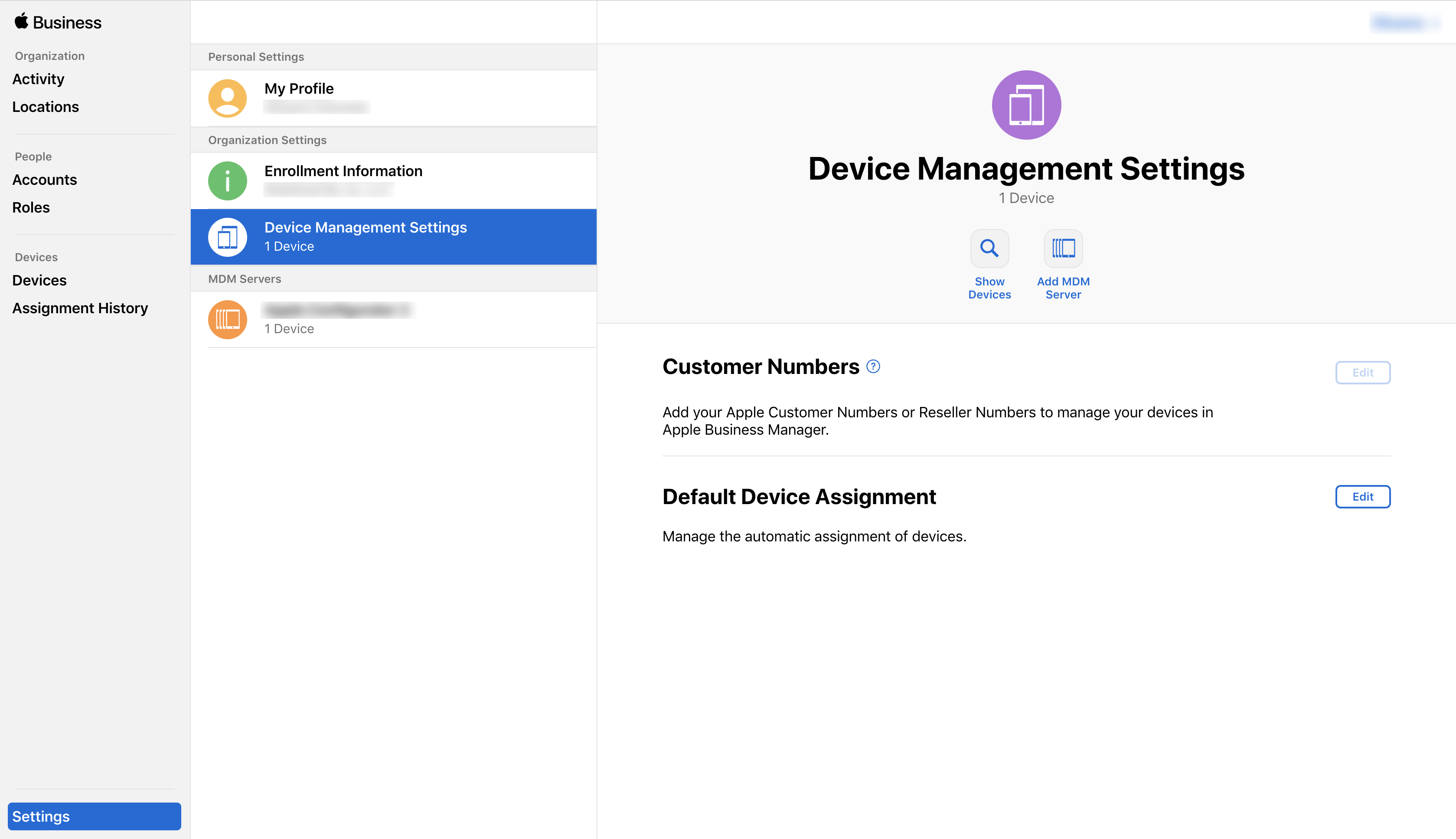
- In theMDM Server Namesetting, type a name for the XenMobile server. The server name that you type is for your reference. It’s not the server URL or name.
- UnderUpload Public Key, clickChoose File。Upload the public key that you downloaded from XenMobile and then save the changes.
ClickDownload Tokento download the server token file to your computer.
You must upload the server token file when adding the ABM account to XenMobile. Your ABM token information appears in the XenMobile console after you import the token file.
- UnderDefault Device Assignment, clickChange。Choose how you want to assign devices and then provide the information requested. For information, see theABM User Guide。
Step 3: Add an ABM account to XenMobile
You can add multiple ABM accounts to XenMobile. This feature enables you to use different enrollment settings and setup assistant options by country, department, and so on. You then associate ABM accounts with different device policies.
For example, you might centralize all of your ABM accounts from different countries on the same XenMobile server, to import and supervise all ABM devices. By customizing enrollment settings and setup assistant options per department, organizational hierarchy, or other structure, policies provide appropriate functionality across your organization, and users receive the appropriate assistance.
In the XenMobile console, go toSettings > Apple Deployment Programand, underAdd Apple Deployment Program Account, clickAdd。

In theServer Tokenspage, specify your server token file and then clickUpload。
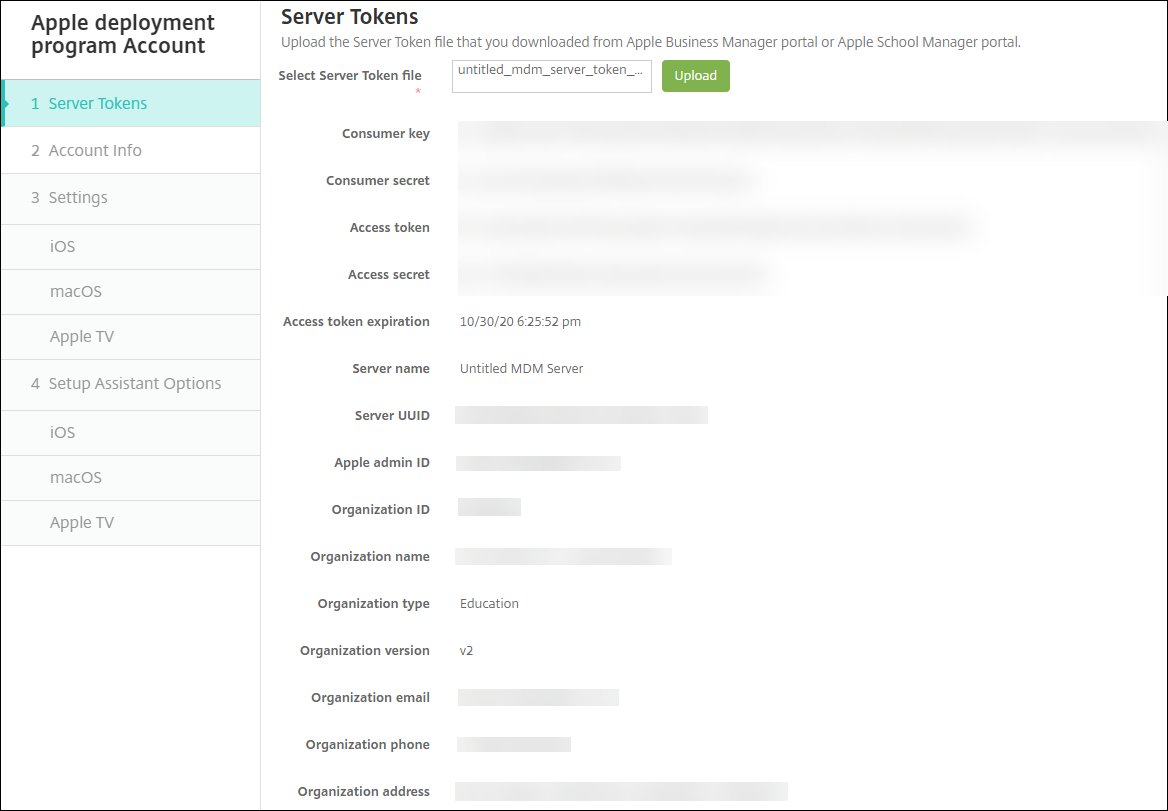
Your server token information appears.
In theAccount Infopage, specify these settings:
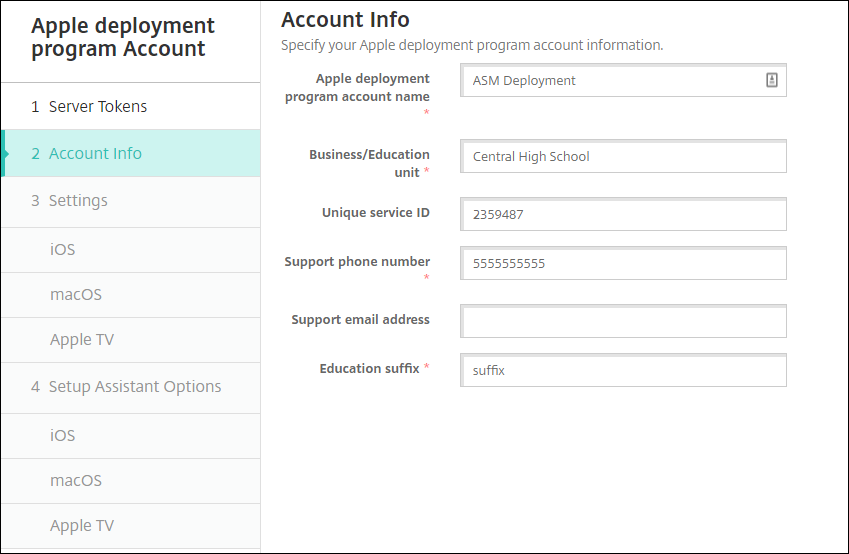
- Apple Deployment Program account name:A unique name for this Apple Deployment Program account. Use names that reflect how you organize Apple Deployment Program accounts, such as by country or organizational hierarchy.
- Business/Education unit:The business unit or department to which the device is assigned. This field is required.
- Unique service ID:An optional unique ID to help you further identify the account.
- Support phone number:A support phone number that users call for help during setup. This field is required.
- Support email address:An optional support email address available to end users.
IniOS Settings, specify these settings:
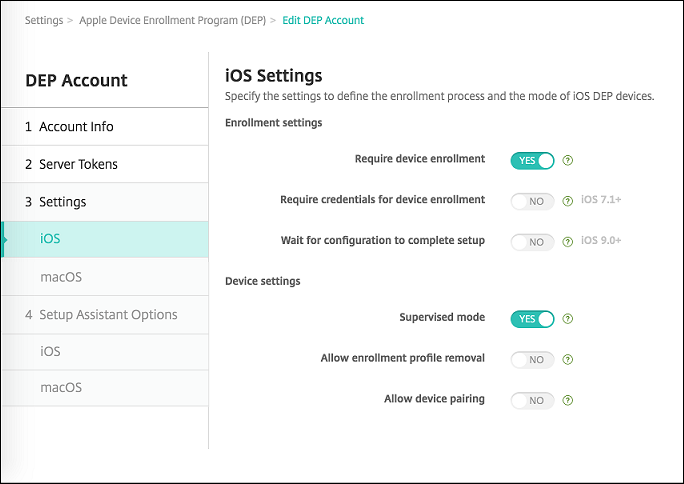
Enrollment settings:
- Require device enrollment:Whether to require users to enroll their devices. The default isYes。
Require credentials for device enrollment:Whether to require users to enter their credentials during ABM setup. Citrix recommends that you require all users to enter their credentials during device enrollment, thus allowing only authorized users to enroll devices. The default isYes。
When you enable ABM before first time setup and you don’t select this option, XenMobile creates the ABM components. This creation includes components such as ABM user, Secure Hub, software inventory, and ABM deployment group. If you do select this option, XenMobile doesn’t create the components. As a result, if you later clear this option, users who haven’t entered their credentials can’t enroll in ABM because these ABM components don’t exist. To add ABM components, in that case, disable and enable the ABM account.
- Wait for configuration to complete setup:Whether to require users’ devices to remain in Setup Assistant mode until all MDM resources deploy to the device. This setting is available for devices in supervised mode. The default isNo。
- Apple documentation states that the following commands may not work while a device is in Setup Assistant mode:
- InviteToProgram
- InstallApplication
- ApplyRedemptionCode
- InstallMedia
- RequestMirroring
- DeviceLock
Device settings:
- Supervised mode:Must be set toYesif you are using the Apple Configurator to manage ABM enrolled devices or whenWait for configuration to complete setupis enabled. The default isYes。为维etails on placing an iOS device in supervised mode, seeTo place an iOS device in Supervised mode by using the Apple Configurator。
- Allow enrollment profile removal:Whether to allow devices to use a profile that you can remove remotely. The default isNo。
- Allow device pairing:为维evices enrolled through ABM, whether you can manage them through Apple Music and the Apple Configurator. The default isNo。
Supervision Identities
If you use the GroundControl tool, you can add a certificate to do the following:
- Override pairing restrictions to avoid the “Trust this host” prompt.
- Escalate managed device actions over USB to perform activities such as profile installation without user interaction. Doing so allows GroundControl to enable single app mode and device lock for checkout.
- Restore a backup to ABM devices.
For more information on GroundControl, seeThe GroundControl website。
InmacOS Settings, specify these settings:
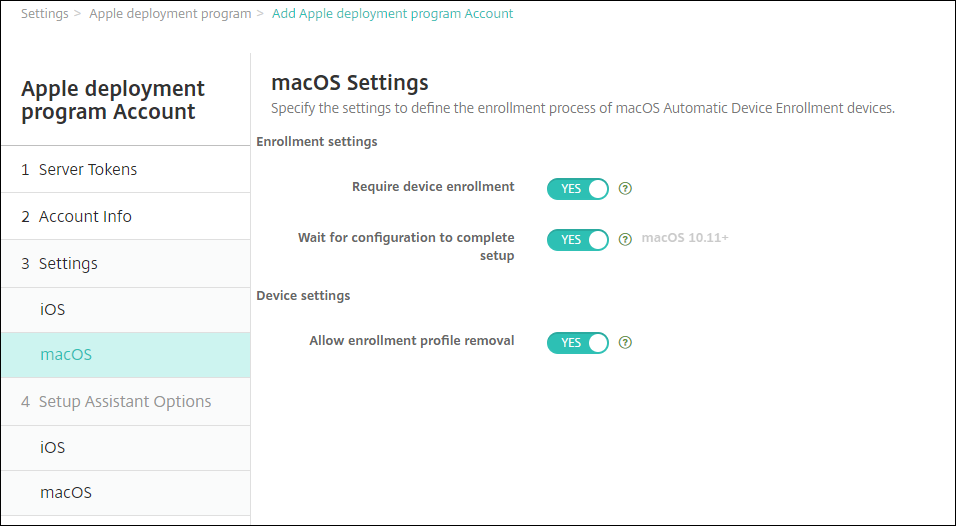
Enrollment settings:
- Require device enrollment:Whether to require users to enroll their devices. The default isYes。
- Wait for configuration to complete setup:IfYes, the macOS device doesn’t continue in the setup assistant until the MDM resource passcode gets deployed to the device. That deployment occurs before the creation of the local account. This setting is available for macOS 10.11 and higher devices. The default isNo。
Device settings:
- Allow enrollment profile removal:Whether to allow devices to use a profile that you can remove remotely. The default isNo。
IniOS Setup Assistant Options, select the steps that the iOS Setup Assistant skips when users start their devices the first time. When a screen is skipped, the related feature uses default settings. Users can configure the skipped features after setup completes unless you restrict access to those features completely. For more information about restricting access to features, seeRestrictions device policy。The default for all items is cleared. The following descriptions explain what occurs when a setting is selected.
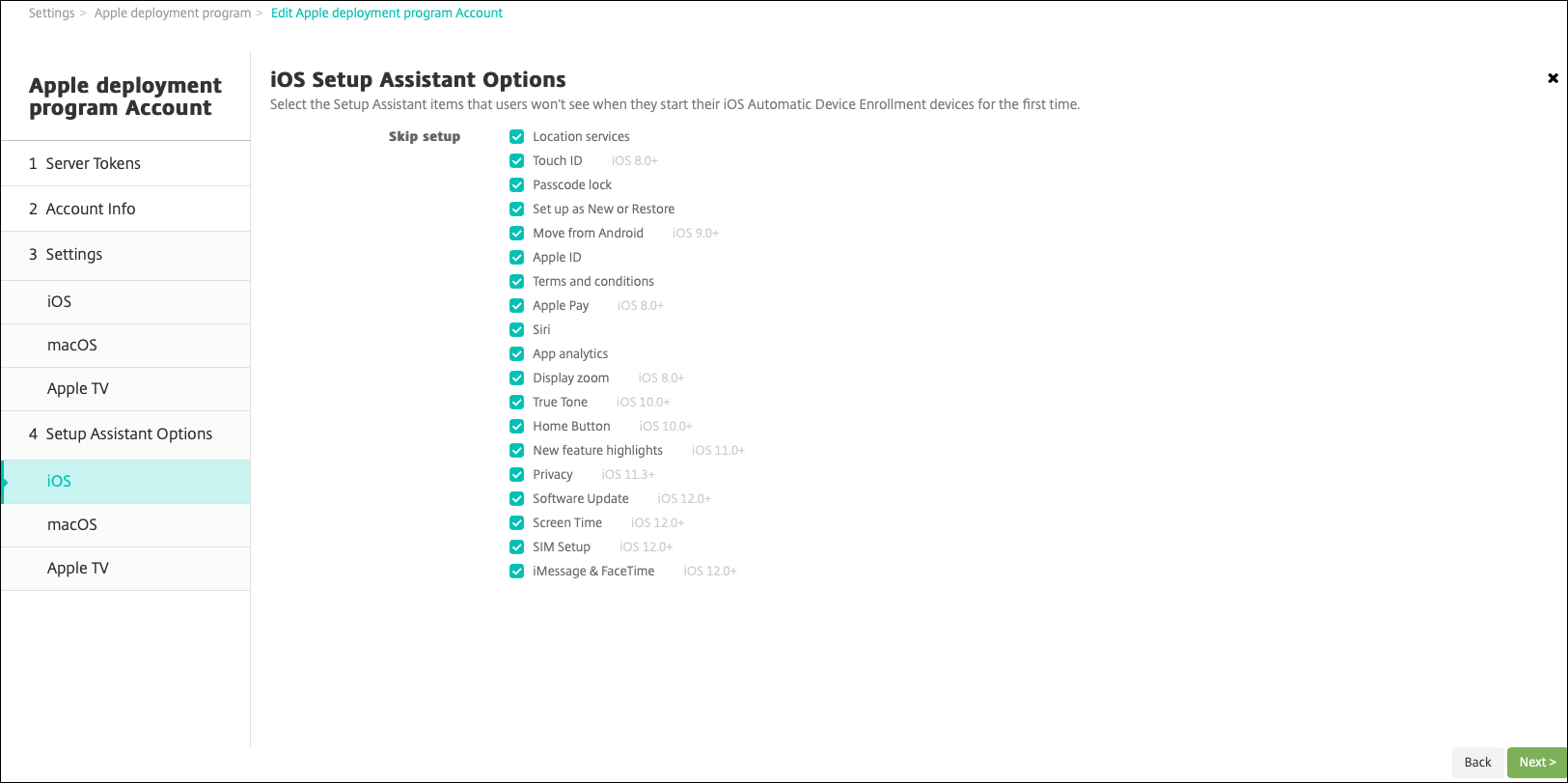
- Location services:Prevents users from setting up the location service on the device.
- Touch ID:Prevents users from setting up Touch ID or Face ID on iOS devices.
- Passcode lock:Prevents users from setting up a passcode for the device. If no passcode exists, users can’t use Touch ID or Apple Pay.
- Set up as new or restore:Prevents users from setting up the device as new or from an iCloud or Apple App Store backup.
- Move from Android:Prevents users from transferring data from an Android device to an iOS device. This option is available only whenSet up as new or restoreis selected (that is, the step is skipped).
- Apple ID:Prevents users from setting up a Managed Apple ID account for the device.
- Terms and conditions:Prevents users from reading and accepting terms and conditions for use of the device.
- Apple Pay:Prevents users from setting up Apple Pay. If this setting is cleared, users must set up Touch ID and Apple ID. Ensure that those settings are cleared.
- Siri:Prevents the user from configuring Siri.
- App analytics:Prevents users from setting up whether to share crash data and usage statistics with Apple.
- Display zoom:Prevents users from setting up the display resolution (either standard or zoomed) on iOS devices.
- True Tone:Prevents users from setting up four-channel sensors to dynamically adjust the white balance of the display.
- Home button:防止用户设置按钮猪圈le of feedback.
- New feature highlights:Prevents users from seeing screens that display information about new features of Apple software.
- Privacy:Prevent users from seeing the data and privacy pane. For iOS 11.3 and later.
- Software update:Prevents users from updating iOS to the latest version. For iOS 12.0 and later.
- Screen Time:Prevents users from enabling Screen Time. For iOS 12.0 and later.
- SIM setup:Prevents users from setting up a cellular plan. For iOS 12.0 and later.
- iMessage & FaceTime:Prevents users from enabling iMessage and FaceTime. For iOS 12.0 and later.
- Appearance:Prevents users from selecting the appearance mode. For iOS 13.0 and later.
- Welcome:Prevents the user from seeing theGet Startedscreen. For iOS 13.0 and later.
- Restore completed:Prevents users from seeing whether a restore completes during setup. For iOS 14.0 and later.
- Update completed:Prevents users from seeing whether a software update completes during setup. For iOS 14.0 and later.
The ABM account appears onSettings > Apple Deployment Program。
InmacOS Setup Assistant Options, select the steps that the macOS Setup Assistant skips when users start their devices the first time. When a screen is skipped, the related feature uses default settings. Users can configure the skipped features after setup completes unless you restrict access to those features completely. For more information about restricting access to features, seeRestrictions device policy。The default for all items is cleared. The following descriptions explain what occurs when a setting is selected.
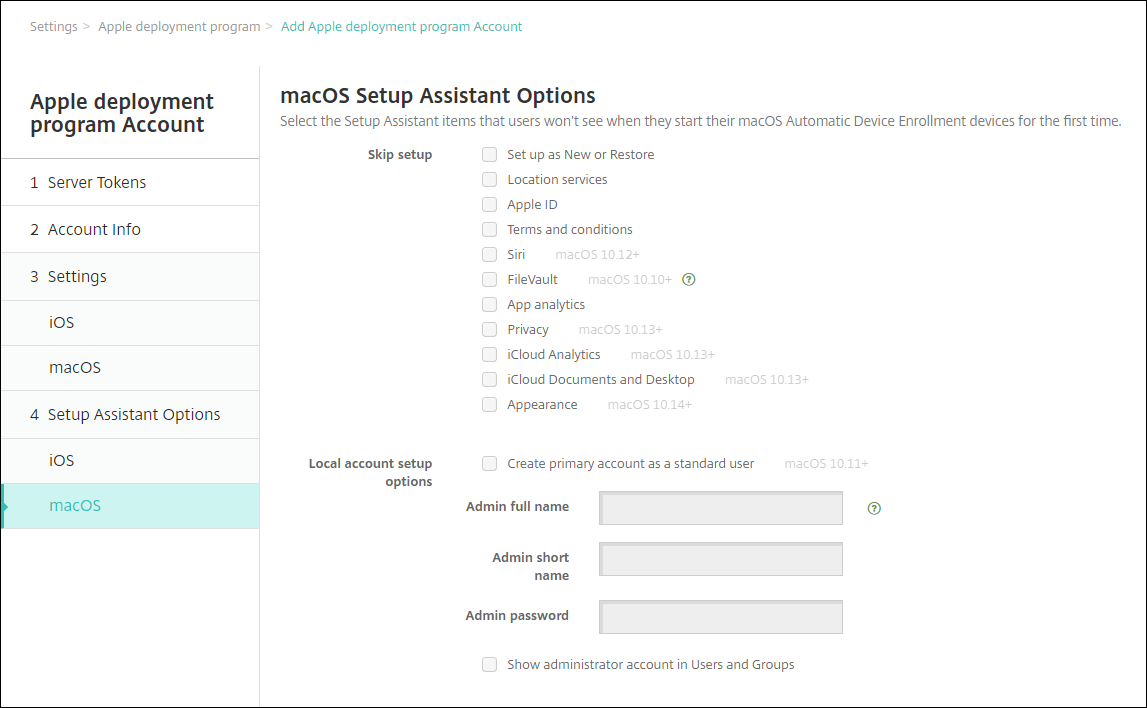
- Set up as new or restore:Prevents users from setting up the device as new or from a Time Machine backup or perform a system migration.
- Location services:Prevents users from setting up the location service on the device. For macOS 10.11 and later.
- Apple ID:Prevents users from setting up a Managed Apple ID account for the device.
- Terms and conditions:Prevents users from reading and accepting terms and conditions for use of the device.
- Siri:Prevents the user from configuring Siri. For macOS 10.12 and later.
FileVault:Use FileVault to encrypt the startup disk. XenMobile only applies the FileVault setting if the system has a single local user account and that account is signed into iCloud.
You can use the macOS FileVault Disk Encryption feature to protect the system volume by encrypting its contents (https://support.apple.com/en-us/HT204837). If you run the Setup assistant on a late-model portable Mac that doesn’t have FileVault turned on, you might be prompted to turn on this feature. The prompt appears on both new systems and systems upgraded to OS X 10.10 or 10.11, but only if the system has a single local administrator account and that account is signed into iCloud.
- App analytics:Prevents users from setting up whether to share crash data and usage statistics with Apple.
- Privacy:Prevent users from seeing the Data and privacy pane. For macOS 10.13 and later.
- iCloud Analytics:Prevent users from choosing whether to send diagnostic iCloud data to Apple. For macOS 10.13 and later.
- iCloud Documents and Desktop:Prevent users from setting up the iCloud Desktop and Documents. For macOS 10.13 and later.
- Appearance:Prevents users from selecting the appearance mode. For macOS 10.14 and later.
- Accessibility:Prevents the user from hearing Voice Over automatically. Only available if the device is connected to Ethernet. For macOS 11 and later.
- 生物识别:Prevents the user from setting up Touch ID and Face ID. For macOS 10.12.4 and later.
- True Tone:Prevents users from setting up four-channel sensors to dynamically adjust the white balance of the display. For macOS 10.13.6 and later.
- Apple Pay:Prevents users from setting up Apple Pay. If this setting is cleared, users must set up Touch ID and Apple ID. Ensure that theApple IDand生物识别settings are cleared. For macOS 10.12.4 and later.
Screen Time:Prevents users from enabling Screen Time. For macOS 10.15 and later.
- Local account setup options:Specify the settings to create an administrator account on the device. Users log in to their macOS device with this information. XenMobile creates the account, using the specified information.
- Create primary account as a standard user:而不是授予该用户管理员privileges on the device, XenMobile creates the user with standard permissions. Because macOS requires an administrator account, XenMobile creates an administrator account first, then makes a new standard account and sets it as primary.
- Admin full name:Type the name the system displays for the administrator account.
- Admin short name:Type the name that the device displays for the home folder and in the shell.
- Admin password:Type a secure password for the administrator account.
- Show administrator account in Users and Groups:If cleared, the administrator account doesn’t appear inUsers and Groupsin the macOS settings. If you create the primary account as a standard user, enable this setting to hide the administrator account XenMobile creates first.
Order Deployment Program enabled devices
You can order Deployment Program enabled devices directly from Apple or Deployment Program enabled authorized resellers or carriers. To order from Apple, provide your Apple Customer ID in the Apple Deployment Program Portal. Your Customer ID enables Apple to associate your purchased devices with your Apple Deployment Program account.
To order from your reseller or carrier, contact your Apple reseller or carrier to check if they participate in the Apple Deployment Program. Ask for the Apple Deployment Program ID of the reseller when purchasing devices. Apple requires that information when you add your Apple Deployment Program reseller to your Apple Deployment Program account. After you add the Apple Deployment Program ID for the reseller, you receive a Deployment Program customer ID. Provide the Deployment Program customer ID to the reseller, who uses the ID to submit information about your device purchases to Apple. For more information, see thisApple Use Device Enrollment site。
Manage Deployment Program enabled devices
After your order ships, you can associate iOS, iPadOS, and macOS devices with your XenMobile server.
- Sign in toApple Business Managerusing an administrator or device enrollment manager account.
- In the sidebar, clickDevices。Devices you purchased directly from Apple appear automatically. To assign devices from Apple Configurator 2 to Apple Business Manager, seeApple Business Manager User Guide。
- In the list, select a device or the total number of devices and clickEdit Device Management。You have two options:
To assign a device to an MDM server, underAssign to Server, choose the name of your XenMobile server. ClickContinue。
To assign new devices to Apple Business Manager in bulk, set a default XenMobile server for deployment. For more information, seeSet a default server for bulk enrollment。
To unassign a device from the XenMobile server, chooseUnassign。
Your Apple Deployment Program devices are now associated with the selected XenMobile server.
If you send in an iOS, iPadOS, or macOS device for servicing, you need to remove the device from Apple Business Manager. When you receive the serviced device back, you must reassign the device to the XenMobile server. When you replace the device, you can assign a new device to the XenMobile server using an order number.
To review the history of assigned devices:
- Sign in toApple Business Managerusing an administrator or device enrollment manager account.
- In the sidebar, clickAssignment History。Then choose an assignment to view more information.
- ClickDownloadto download a CSV file with the serial numbers of all assigned and unassigned devices.
You can remove iOS, iPadOS, and macOS devices from Apple Business Manager if the device has been sold, stolen, or can’t be repaired.
- Sign in toApple Business Managerusing an administrator or device enrollment manager account.
- In the sidebar, clickDevicesand search for a device.
- Select a device and clickRelease Device。In the dialog box, confirm your changes to remove the device from the program. To add iOS and iPadOS devices back, use Apple Configurator 2. You can’t add macOS devices back with Apple Configurator 2.








